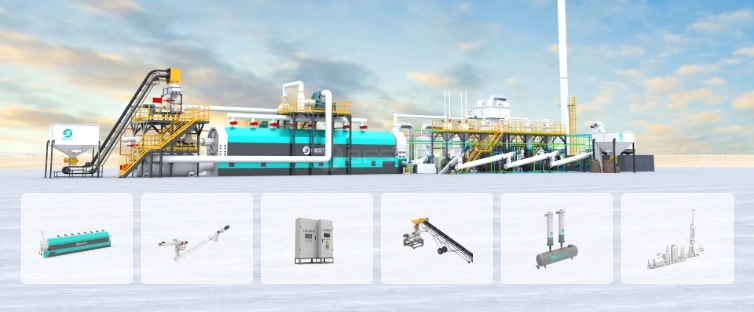As the global volume of solid waste continues to surge, the limitations of conventional mechanical recycling are becoming increasingly evident. While mechanical processes are vital for reprocessing certain materials like PET and HDPE, they are not suitable for all types of waste—particularly low-grade, mixed, and contaminated plastics. To achieve holistic waste reduction and a circular economy, chemical recycling technologies like pyrolysis are emerging as indispensable tools.
Mechanical Recycling: Benefits and Shortcomings
Mechanical recycling involves sorting, washing, shredding, and remelting plastic waste into new products. It is cost-effective and energy-efficient when the input materials are clean and homogenous. However, the process faces several barriers:
- Contamination: Food residues, multilayer films, and dyes reduce recyclability.
- Downcycling: Recycled plastic often suffers quality degradation after each cycle.
- Limited polymer compatibility: Some plastics, like polystyrene or PVC, are rarely accepted by mechanical systems.
These challenges leave a significant portion of plastic waste either incinerated or sent to landfills. This is where pyrolysis comes in to bridge the gap.
What is Pyrolysis Chemical Recycling?
Pyrolysis is a thermochemical process that converts organic waste—such as plastics and rubber—into fuel-like products through high temperatures in an oxygen-free environment. Unlike mechanical recycling, pyrolysis breaks down polymers at the molecular level, making it capable of processing complex and contaminated waste streams.
A modern plastic pyrolysis plant can handle items that are otherwise unrecyclable: grocery bags, mixed plastic packaging, and even soiled containers. This complements mechanical recycling by covering its blind spots and offering a zero-waste alternative for problematic plastics.
Continuous Pyrolysis: A Scalable, Efficient Solution
Traditional batch-based pyrolysis systems were once limited by their slow processing speeds and labor demands. However, the evolution of continuous pyrolysis reactor designs has significantly changed the landscape. These advanced systems enable uninterrupted operation, higher throughput, and automation of feeding and discharging, making them ideal for industrial-scale waste treatment.
Continuous pyrolysis systems not only reduce operating costs but also produce consistent product quality. This makes the process reliable for businesses looking to extract value from plastic and tire waste on a long-term basis.
How Pyrolysis Machinery Advances Waste Management Goals
Innovative pyrolysis machinery now includes sophisticated control systems, emissions purification modules, and flexible designs to accommodate various feedstock types. These improvements enhance the environmental performance and operational safety of the systems, aligning with modern sustainability requirements.
Furthermore, modular pyrolysis units can be integrated into existing mechanical recycling facilities to expand their waste processing capabilities. This hybrid approach ensures maximum material recovery and improved economics for waste management operators.

Environmental and Economic Benefits of Integration
When combined, mechanical and chemical recycling offer numerous benefits:
- Diverts a broader range of waste from incinerators and landfills
- Increases overall recycling rates for difficult-to-handle materials
- Reduces dependency on virgin fossil-based raw materials
- Enhances the value chain with diverse byproducts (oil, gas, carbon black)
This synergistic model ensures that every material stream is treated with the most appropriate technology, optimizing both ecological outcomes and financial returns.
Tyre Pyrolysis as a Complement to Plastic Recovery
Rubber waste, especially used tires, is another material poorly served by mechanical recycling. With rising tire disposal volumes and few reuse options, chemical recycling through pyrolysis has become essential. A continuous tyre pyrolysis plant allows for non-stop processing of shredded tires into oil, carbon black, and steel wire, all of which can be reused or sold commercially.
This not only diverts large quantities of rubber waste from landfills but also generates alternative fuel sources, adding to the energy grid without contributing to fossil fuel extraction.
Global Adoption and Policy Support
As governments tighten waste and emissions regulations, pyrolysis is gaining acceptance worldwide. Several countries have begun offering subsidies and tax incentives to facilities that adopt chemical recycling. Global brands in packaging, automotive, and consumer goods are also investing in pyrolysis to meet their recycled content and carbon neutrality goals.
The scalability of continuous pyrolysis systems means that municipalities, recyclers, and private companies can now deploy modular installations based on regional waste volumes and feedstock availability.
Conclusion: Toward a Fully Circular Waste Ecosystem
Mechanical recycling remains an essential pillar of waste management, but it cannot solve the problem alone. Chemical recycling through pyrolysis offers the missing link—capable of processing the rest of the waste stream that mechanical systems leave behind.
By deploying advanced pyrolysis technologies alongside existing systems, we can significantly reduce the total volume of solid waste, recover more resources, and move closer to a truly circular economy. With providers like Beston Group offering end-to-end solutions in plastic pyrolysis and tire recycling, the future of sustainable waste management is already here.